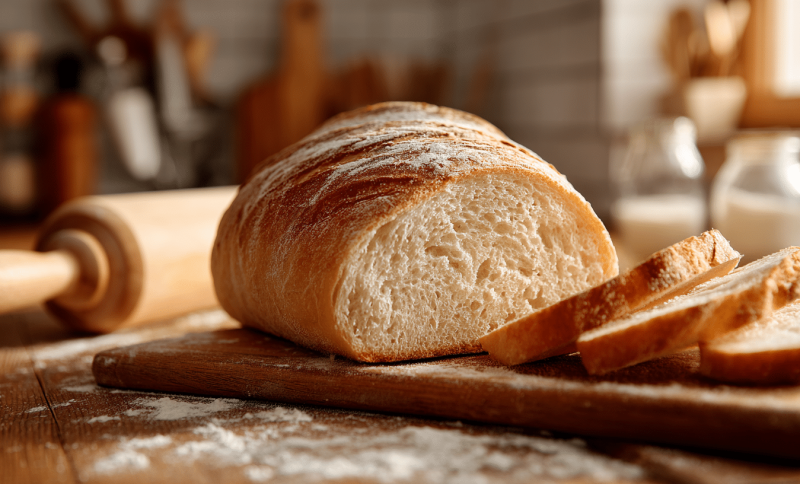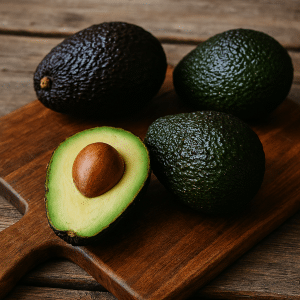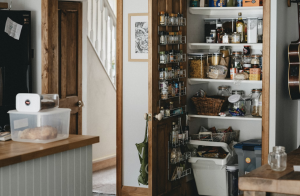If you’re a fan of Jimmy John’s subs, you know that the bread is just as crucial as the fillings.
Their bread is soft, slightly sweet, and perfectly crunchy on the outside, creating the ideal base for any sub.
Now, with this simple copycat recipe, you can bring that signature Jimmy John’s bread right into your own kitchen.
There’s something incredibly satisfying about baking your own fresh loaf that matches the flavor and texture you love.
If you’re making a classic sub or experimenting with your fillings, this homemade bread will enhance your sandwich experience.
Get ready to recreate that perfect Jimmy John’s-style bread and enjoy fresh, delicious subs made right at home.
What Makes Jimmy Johns Bread So Unique?
What makes Jimmy John’s bread so unique is its perfect balance of texture, flavor, and consistency.
The bread’s slightly sweet, soft interior melts in your mouth, paired with a crisp, golden crust that holds up well against hearty sandwich fillings.
The texture is light and airy, yet sturdy enough to carry all the fresh veggies, meats, and sauces without falling apart.
Key ingredients play a significant role in achieving this balance. The use of high-quality flour gives the bread its soft, fluffy interior, while a small amount of sugar adds a subtle sweetness.
Ingredients You’ll Need
|
Recipe Notes
| Info | Details |
|---|---|
| Prep Time | 1 hour 15 minutes (includes dough rising time) |
| Cook Time | 20-25 minutes |
| Category | Bread, Sandwich Bread |
| Method | Baking |
| Cuisine | American |
| Yield | 2 loaves (each perfect for several sandwiches) |
Step-By-Step Guide to Jimmy John’s Bread Recipe at Home
Learn how to recreate the signature Jimmy John’s bread in your kitchen with this simple, easy-to-follow guide. From mixing the ingredients to baking the perfect loaf, you’ll have fresh, delicious bread ready for your subs in no time.
Step 1: Activate the Yeast

Begin by dissolving the sugar in warm water in a large mixing bowl. The sugar acts as food for the yeast, helping it to activate.
Sprinkle yeast over water and sugar. Let sit 5-10 minutes until it bubbles and froths, indicating it’s active. If your yeast doesn’t bubble, it may be expired or the water temperature may be incorrect. Yeast must be activated for proper bread rising.
Pro Tip: Ensure the water is warm, not hot, at around 110°F. If it’s too hot, it can kill the yeast, and if it’s too cold, it won’t activate properly. If you’re unsure, use a kitchen thermometer to check!
Step 2: Mix the Ingredients

Add the olive oil, salt, and 3 cups of flour to the yeast mixture. Stir the ingredients together until a dough starts to form.
Gradually add the remaining flour, a little at a time, until the dough pulls away from the sides of the bowl and is soft but not sticky.
Pro Tip: If the dough feels too sticky, add a little more flour, but be careful not to overdo it. The dough should be soft and slightly tacky to the touch.
Step 3: Knead the Dough

Turn the dough out onto a floured surface. Knead the dough for about 8-10 minutes. This step is essential for developing the gluten, which gives the bread its structure and chewiness.
Knead by pushing dough away with palms, folding, then rotating a quarter turn until smooth, elastic, and not sticking. Use a stand mixer with a dough hook for easier kneading. Hand kneading helps you feel the dough.
Pro Tip: When kneading, push the dough away from you with the palms of your hands, then fold it over and rotate. If it starts sticking to the counter, sprinkle a tiny bit of flour underneath, but be careful not to add too much.
Step 4: Let the Dough Rise

Place the kneaded dough in a lightly oiled bowl. Cover the bowl with a clean towel or plastic wrap and let it rise in a warm, draft-free area.
The dough should double in size in about 1 hour as yeast ferments, producing carbon dioxide that causes it to rise. To speed up the process, place the bowl in a warm oven set to 200°F for a few minutes to help the dough rise.
Pro Tip: If you’re in a hurry, preheat your oven to 200°F for just a few minutes, then turn it off. Place the dough in the warm oven with the door slightly ajar to speed up the rising process.
Step 5: Shape the Bread Dough

Once the dough has doubled in size, punch it down to release any air bubbles. Turn it out onto a lightly floured surface. Divide the dough into two equal portions.
Shape each portion into a long loaf by gently rolling and stretching the dough, ensuring even length. Use a ruler to measure and match loaves for uniform size, which helps them bake evenly.
Pro Tip: For a more uniform bread, use a ruler to ensure each loaf is the same length. This helps with even baking.
Step 6: Prepare the Loaves for Baking

Once your loaves are shaped, place them on a baking sheet lined with parchment paper. For a crispier crust, dust the loaves with cornstarch; this helps them form a beautiful, crackling exterior as they bake.
Cover the loaves with a clean towel and let them rise for about 30 minutes until puffed and slightly swollen. Before baking, slash the top of each loaf to help it expand evenly and create a textured crust.
Pro Tip: Before baking, use a sharp knife or razor blade to make a few shallow slashes along the top of the loaves. This helps the bread expand evenly as it bakes.
Step 7: Bake the Bread

Preheat your oven to 375°F. Place your loaves in the oven and bake them for 20-25 minutes. The bread is done when it’s golden brown on top and sounds hollow when tapped on the bottom.
To ensure the loaves develop a crispy, golden crust, you can place a small dish of water on the bottom rack of the oven. The steam from the water will help achieve that perfect, crunchy texture on the outside.
Pro Tip: For a super-crispy crust, place a small dish of water on the bottom rack of the oven while baking. The steam helps create a better texture on the bread’s crust.
Step 8: Cool and Enjoy

Remove the bread from the oven and transfer it to a wire rack to cool for at least 15 minutes. Allowing the bread to cool before slicing helps it set and makes it easier to cut without squishing the texture.
Once cooled, slice and enjoy! For that signature Jimmy John’s flavor, you can brush the tops of the loaves with melted butter right after they come out of the oven.
Pro Tip: For an extra flavor boost, brush the tops of the loaves with melted butter as soon as they come out of the oven, achieving that signature Jimmy John’s finish.
Nutritional Facts
| Nutrition | Amount Per Serving |
|---|---|
| Calories | 180 kcal |
| Sugar | 3g |
| Sodium | 220mg |
| Fat | 3g |
| Carbs | 33g |
| Fiber | 1g |
| Protein | 5g |
Pro Tips for Storing and Reheating the Bread
To keep your homemade bread fresh, store it in an airtight container or plastic bag at room temperature for up to 3 days.
For more extended storage, freeze it in a tightly sealed bag for up to 3 months. When reheating, wrap the bread in foil and warm it in the oven at 350°F for approximately 10 minutes to achieve a crispy crust and a soft interior.
How to Store the Bread for Later Use
- Once the bread has completely cooled, wrap each loaf tightly in plastic wrap or aluminum foil. This helps retain moisture and prevents the bread from drying out.
- For longer storage, you can freeze the bread. Wrap it in plastic wrap, then place it in a freezer-safe bag or an airtight container. When ready to use, let it thaw at room temperature or heat it in the oven.
- If you plan to eat the bread within a few days, store it at room temperature in an airtight container or bread box to keep it fresh.
Best Practices for Reheating to Maintain Freshness
- Oven: Preheat your oven to 350°F. Wrap the bread in foil to retain moisture and bake for about 10-15 minutes. This will warm the bread and make the crust slightly crispy again.
- Microwave: For quick reheating, wrap the bread in a damp paper towel and microwave it in 15-20 second intervals. This keeps the bread soft, though it won’t crisp up like when baked in the oven.
- Toaster Oven: For a nice, crispy crust, use a toaster oven set to 350°F for 5-7 minutes. This will warm the bread while giving the crust that delightful crunch.
Easy Homemade Copycat Jimmy Johns Bread Recipes
This easy soft-bread recipe is perfect for anyone looking to recreate that signature Jimmy Johns taste at home. With just a few simple ingredients and some patience, you can make bread dough that transforms into the perfect sub sandwich base. Word has spread about how easy homemade bread can be, and this recipe proves it. Many bread recipes claim to be authentic, but this copycat jimmy johns version truly delivers on taste and texture.
Bringing It All Together
Baking homemade bread for subs is such a rewarding experience. The soft, warm texture and crisp crust make your sandwich even more enjoyable, enhancing each bite.
I hope this recipe brings the joy of fresh, delicious bread straight to your kitchen and helps you create memorable meals.
There’s something special about making bread; it truly improves your sandwich game. I encourage you to give It a try, and don’t forget to experiment with your favorite sandwich fillings!
Share the creations! Snap a photo of homemade subs and tag on social media, or leave a comment below with any baking experiences. Happy baking and enjoy the homemade subs!













